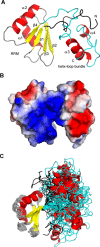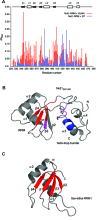Structure and semi-sequence-specific RNA binding of Nrd1
- PMID: 24860164
- PMCID: PMC4081072
- DOI: 10.1093/nar/gku446
Structure and semi-sequence-specific RNA binding of Nrd1
Abstract
In Saccharomyces cerevisiae, the Nrd1-dependent termination and processing pathways play an important role in surveillance and processing of non-coding ribonucleic acids (RNAs). The termination and subsequent processing is dependent on the Nrd1 complex consisting of two RNA-binding proteins Nrd1 and Nab3 and Sen1 helicase. It is established that Nrd1 and Nab3 cooperatively recognize specific termination elements within nascent RNA, GUA[A/G] and UCUU[G], respectively. Interestingly, some transcripts do not require GUA[A/G] motif for transcription termination in vivo and binding in vitro, suggesting the existence of alternative Nrd1-binding motifs. Here we studied the structure and RNA-binding properties of Nrd1 using nuclear magnetic resonance (NMR), fluorescence anisotropy and phenotypic analyses in vivo. We determined the solution structure of a two-domain RNA-binding fragment of Nrd1, formed by an RNA-recognition motif and helix-loop bundle. NMR and fluorescence data show that not only GUA[A/G] but also several other G-rich and AU-rich motifs are able to bind Nrd1 with affinity in a low micromolar range. The broad substrate specificity is achieved by adaptable interaction surfaces of the RNA-recognition motif and helix-loop bundle domains that sandwich the RNA substrates. Our findings have implication for the role of Nrd1 in termination and processing of many non-coding RNAs arising from bidirectional pervasive transcription.
© The Author(s) 2014. Published by Oxford University Press on behalf of Nucleic Acids Research.
Figures





Similar articles
-
The structure of transcription termination factor Nrd1 reveals an original mode for GUAA recognition.Nucleic Acids Res. 2017 Sep 29;45(17):10293-10305. doi: 10.1093/nar/gkx685. Nucleic Acids Res. 2017. PMID: 28973465 Free PMC article.
-
The Nrd1-Nab3-Sen1 transcription termination complex from a structural perspective.Biochem Soc Trans. 2023 Jun 28;51(3):1257-1269. doi: 10.1042/BST20221418. Biochem Soc Trans. 2023. PMID: 37222282 Free PMC article. Review.
-
Recognition of transcription termination signal by the nuclear polyadenylated RNA-binding (NAB) 3 protein.J Biol Chem. 2011 Feb 4;286(5):3645-57. doi: 10.1074/jbc.M110.158774. Epub 2010 Nov 17. J Biol Chem. 2011. PMID: 21084293 Free PMC article.
-
Interactions of Sen1, Nrd1, and Nab3 with multiple phosphorylated forms of the Rpb1 C-terminal domain in Saccharomyces cerevisiae.Eukaryot Cell. 2012 Apr;11(4):417-29. doi: 10.1128/EC.05320-11. Epub 2012 Jan 27. Eukaryot Cell. 2012. PMID: 22286094 Free PMC article.
-
Transcription termination and the control of the transcriptome: why, where and how to stop.Nat Rev Mol Cell Biol. 2015 Mar;16(3):190-202. doi: 10.1038/nrm3943. Epub 2015 Feb 4. Nat Rev Mol Cell Biol. 2015. PMID: 25650800 Review.
Cited by
-
Genome-wide mapping of yeast RNA polymerase II termination.PLoS Genet. 2014 Oct 9;10(10):e1004632. doi: 10.1371/journal.pgen.1004632. eCollection 2014 Oct. PLoS Genet. 2014. PMID: 25299594 Free PMC article.
-
The structure of transcription termination factor Nrd1 reveals an original mode for GUAA recognition.Nucleic Acids Res. 2017 Sep 29;45(17):10293-10305. doi: 10.1093/nar/gkx685. Nucleic Acids Res. 2017. PMID: 28973465 Free PMC article.
-
The Nrd1-Nab3-Sen1 transcription termination complex from a structural perspective.Biochem Soc Trans. 2023 Jun 28;51(3):1257-1269. doi: 10.1042/BST20221418. Biochem Soc Trans. 2023. PMID: 37222282 Free PMC article. Review.
-
The conserved protein Seb1 drives transcription termination by binding RNA polymerase II and nascent RNA.Nat Commun. 2017 Apr 3;8:14861. doi: 10.1038/ncomms14861. Nat Commun. 2017. PMID: 28367989 Free PMC article.
-
Transcriptomes of six mutants in the Sen1 pathway reveal combinatorial control of transcription termination across the Saccharomyces cerevisiae genome.PLoS Genet. 2017 Jun 30;13(6):e1006863. doi: 10.1371/journal.pgen.1006863. eCollection 2017 Jun. PLoS Genet. 2017. PMID: 28665995 Free PMC article.
References
-
- Bentley D. The mRNA assembly line: transcription and processing machines in the same factory. Curr. Opin. Cell Biol. 2002;14:336–342. - PubMed
-
- Steinmetz E.J., Conrad N.K., Brow D.A., Corden J.L. RNA-binding protein Nrd1 directs poly(A)-independent 3′-end formation of RNA polymerase II transcripts. Nature. 2001;413:327–331. - PubMed
-
- Arigo J.T., Eyler D.E., Carroll K.L., Corden J.L. Termination of cryptic unstable transcripts is directed by yeast RNA-binding proteins Nrd1 and Nab3. Mol. Cell. 2006;23:841–851. - PubMed
-
- Thiebaut M., Kisseleva-Romanova E., Rougemaille M., Boulay J., Libri D. Transcription termination and nuclear degradation of cryptic unstable transcripts: a role for the nrd1-nab3 pathway in genome surveillance. Mol. Cell. 2006;23:853–864. - PubMed
MeSH terms
Substances
Associated data
- Actions
LinkOut - more resources
Full Text Sources
Other Literature Sources
Molecular Biology Databases

